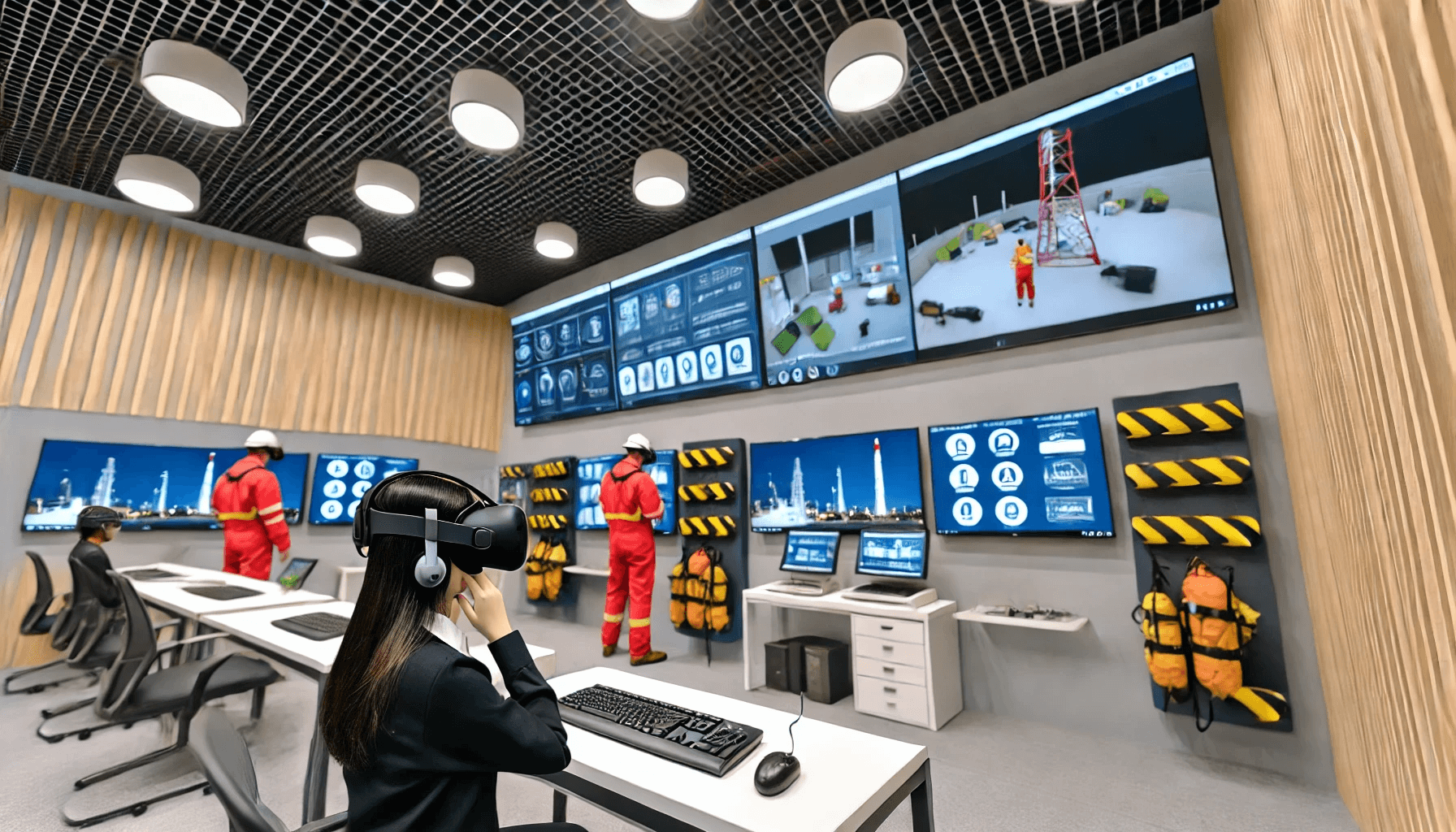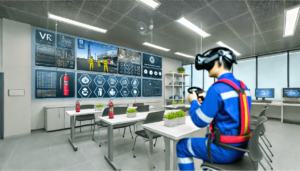In today’s fast-paced and evolving workplace environments, effective risk management training is not just beneficial—it’s essential. The integration of Virtual Reality (VR) into such training processes marks a significant leap forward, offering an immersive experience that traditional methods struggle to match. VR technology brings a hands-on approach to learning that can dramatically enhance understanding and retention of workplace safety protocols, making it an invaluable tool in cultivating a culture of safety preparedness across industries. This innovative approach not only elevates the training experience but also prepares employees more thoroughly for real-world scenarios where accurate risk assessment and timely decision-making are crucial.
As we delve further into this article, we will explore the crucial role of risk management training in maintaining workplace safety, and how VR technology has revolutionized this training by providing engaging, immersive training experiences. From detailed VR simulations that allow for realistic hands-on training scenarios to the practical applications of such technology in various industries, we will provide a comprehensive overview of how organizations can implement VR to enhance their safety and risk management efforts. Our discussion will also touch upon the steps organizations can take to integrate VR technology into their existing training programs, ensuring that their workforce is not only well-prepared to handle potential risks but also equipped with the knowledge and skills to act decisively under pressure.
The Importance of Risk Management Training
Understanding Risk Management
Risk management is fundamentally a process of identifying, analyzing, and prioritizing potential threats to an organization’s objectives. It begins with recognizing hazards—sources of potential harm—and assessing the likelihood that these hazards could cause harm to employees, customers, or the company itself. This awareness is crucial for organizations to manage and mitigate risks effectively, ensuring they can operate smoothly and achieve their strategic goals.
Challenges in Traditional Risk Management Training
Traditional risk management often faces significant hurdles. One major challenge is the complexity of the subject, which can be difficult to simplify for a diverse audience without losing essential information. Additionally, the rapidly changing nature of risks due to advancements in technology and evolving workplace dynamics, such as the rise of hybrid and remote work, requires that risk management training is continuously updated to remain relevant and effective .
Traditional methods may also struggle with engaging learners, as risk management can be perceived as a dry or theoretical topic. This perception can hinder knowledge retention and practical application, making it hard for employees to apply what they’ve learned in real-world situations. Moreover, integrating risk management training into existing workflows without disrupting daily operations presents another challenge, as does addressing biases that may cloud risk management decisions.
By understanding these challenges and the basic principles of risk management, organizations can better prepare their workforce to handle potential risks and make informed decisions that align with their strategic objectives.
How VR Technology Enhances Risk Management Training
Immersive Learning Experience
Virtual Reality (VR) immerses employees in a space that feels real, engaging their senses and fostering a connection to the environment. This immersion is enhanced by spatial audio, which mimics real-world sounds, making interactions within the VR setting more natural and effective. Such immersive experiences not only increase the sense of presence but also facilitate small group collaborations without distractions from other groups.
Real-life Scenarios Without Real-world Risks
VR provides a safe environment where employees can practice high-stakes situations without real-world consequences. This allows for hands-on training in scenarios that would be too dangerous or impractical to replicate in real life. For instance, VR enables training surgeons to perform operations or allows pilots to experience emergency flying conditions without the risks associated with actual flights.
Improved Engagement and Retention
The use of VR in training significantly enhances learner engagement and knowledge retention. Immersive learning allows employees to interact within the learning experience, which has been shown to increase retention rates by up to 75%. Moreover, VR training scenarios are designed to be highly engaging, offering experiences that are both educational and compelling, which helps in maintaining high levels of focus and accelerates the learning process .
Practical Applications of VR in Risk Management Training
Industrial Safety Training
Virtual reality (VR) significantly enhances industrial safety training by creating immersive simulations that allow workers to practice safety procedures without real-world risks. This method not only reduces the risk of accidents but also improves hazard awareness and communication among workers. Industries like oil & gas and manufacturing, where the work environment is particularly hazardous, benefit greatly from VR-enabled training that simulates complex operations such as drilling, well maintenance, and machine operation.
Emergency Response Training
In emergency response training, VR provides a realistic environment where rapid response team (RRT) members can hone their skills under the stress and challenges of simulated emergencies. This type of training is crucial as it prepares responders for real-life situations like natural disasters or health crises without the associated risks. Feedback from participants indicates a high value in the immersive training experience, suggesting that VR training effectively enhances their readiness and effectiveness in the field.
Soft Skills and Empathy Training
VR also plays a pivotal role in training for soft skills and empathy, crucial for managerial success and effective customer interactions. By simulating real-world scenarios, VR allows employees to practice and develop skills such as leadership, communication, and conflict resolution in a controlled, low-pressure environment. This method is particularly effective as it allows for immediate feedback and repeated practice, which are essential for mastering these less tangible but equally important skills.
Implementing VR Technology in Your Organization
Selecting the Right VR Training Programs
Selecting the appropriate virtual reality training provider is crucial for maximizing the benefits of VR training solutions. Organizations should begin by assessing the provider’s industry experience and track record, ensuring they have a history of delivering effective training simulations tailored to specific sectors. It is also important to evaluate the technology used by the training company, including the quality of graphics, realism of simulations, and user-friendliness of interfaces . Compatibility with existing training programs and hardware is essential for seamless integration. Additionally, scalability and customization options are critical; the best VR training companies offer flexible solutions that can adapt to various training needs and accommodate a large number of trainees.
Integrating VR with Existing LMS
Integrating VR into existing Learning Management Systems (LMS) can significantly enhance the tracking and reporting of immersive learning processes. Most modern LMS platforms support SCORM2 or XAPI functionality, which automatically collects results from VR training systems. For organizations using an LMS, it is possible to schedule VR training for learners and access course-specific analytics through these systems. Providers like TrainBeyond offer custom APIs that facilitate external third-party VR integration, ensuring that VR training results are recorded alongside traditional training results within the same system.
Tracking Progress and Results
Effective tracking of VR training involves multiple layers of information, including high-level usage across all groups and courses, benchmarking of courses against each other, and detailed analytics for specific courses. This allows trainers and organizational leaders to view and benchmark historical data at both macro and micro levels. Additionally, tracking user engagement with objects and interaction types is crucial for technical skill training scenarios, providing insights into the effectiveness of the training and areas for improvement.
Conclusion
Throughout this exploration of Virtual Reality (VR) technology in risk management training, we have underscored the transformative power of immersive learning environments. By simulating real-world scenarios without the associated risks, VR technology not only enhances the efficacy of training programs but also significantly elevates engagement and knowledge retention among employees. The practical applications of this technology, spanning from industrial safety to emergency response and soft skills development, highlight VR’s versatility and its profound impact on enhancing workplace preparedness and safety culture across various sectors.
As organizations continue to grapple with dynamic workplace challenges and evolving risks, the adoption of VR for risk management training presents a forward-thinking solution. This approach not only addresses the limitations of traditional training methodologies but also aligns with the need for engaging, practical training solutions that resonate with today’s workforce. By integrating VR technology into their training initiatives, companies are not just preparing their employees to face potential risks; they are investing in a culture of safety and preparedness that is foundational for both individual and organizational success. This commitment to innovative training solutions underscores a broader implication: as we harness technology to enrich learning and development, we pave the way for more resilient and adaptable workplaces.
FAQs
- What are some drawbacks of using VR for training?
Virtual Reality (VR) training is widely used in fields like healthcare, military, entertainment, and education. Despite its popularity, it faces several challenges, including the absence of real-time feedback, difficulties in monitoring learners’ progress, and constraints in tailor-making the training experiences. - How effective is VR in training scenarios?
VR training, often referred to as V-learning, has proven to be more effective than traditional classroom and e-learning methods, particularly in teaching soft skills. Studies show that VR training boosts confidence by 40% compared to traditional classroom settings and offers a 35% greater improvement in the ability to apply learned skills compared to e-learning. - What are the advantages of implementing VR in training programs?
The use of VR in training offers numerous benefits such as quicker mastery of skills, shorter onboarding periods, enhanced customer service, greater workplace safety, reduced employee turnover, fewer expensive errors, and a more efficient method for instilling company culture. - What does virtual reality safety training entail?
Virtual reality safety training utilizes cutting-edge VR technology to create immersive and realistic environments where trainees can practice and hone their reactions and actions in safe, controlled scenarios. This method is transforming training practices across various industries by allowing for risk-free simulation experiences.



